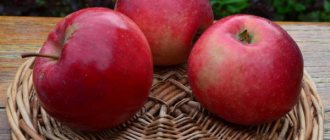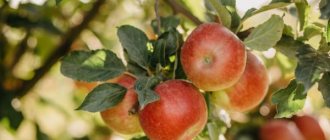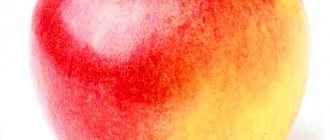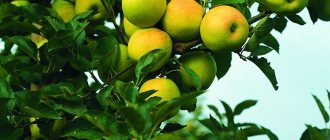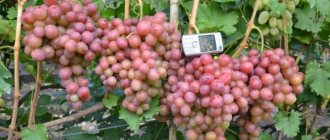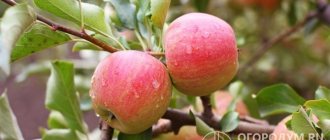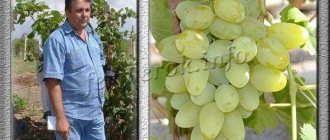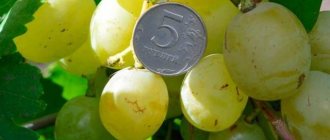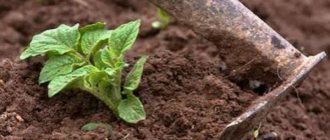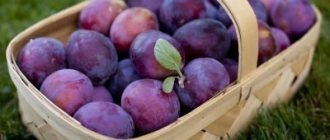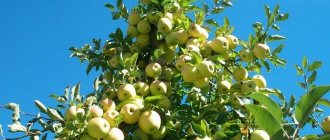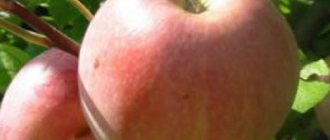Description of the Darunok apple tree variety with photo
The Darunok variety was specially bred for cultivation in the climate of Belarus, so it tolerates moderate winters quite easily, and is also able to survive for some time without precipitation. The powerful root system of an adult tree allows it to easily withstand short-term drying out of the soil.
The fruits of the Darunok apple tree have a small layer of waxy coating
Depending on the rootstock used, the timing of the first harvests may vary. On dwarf and low-growing rootstocks, fruits appear in the 2-3rd year of the tree's life. On average, 3-4 years pass from the moment of planting a one-year-old seedling to the first harvest, depending on the care and growing conditions.
Appearance of fruit and tree
The apple tree has a medium-sized main trunk, rarely reaching a height of more than 3-4 m. The branches of an adult Darunka form a spherical crown with a diameter of up to 6 m. The variety belongs to trees of medium growth strength - this means that the height of the apple tree increases by no more than 20 per year -30 cm.
Important! Depending on the rootstock used, the height of the mature plant can vary significantly.
The most significant factor when choosing this variety for a summer cottage or garden plot is the appearance of the fruit. Darunok in Belarusian means “gift” - the reason for this name becomes clear. The fruits are very large, reaching 180-200 g. Their shape is slightly asymmetrical, with barely noticeable ribs on the surface. The flesh is greenish. The thick red skin has a strong waxy coating.
Lifespan
The active growing season of any apple tree can vary due to many factors. Regardless of the variety, most trees live up to 30-40 years, maintaining a period of active fruiting for up to 25 years. When growing Darunka on dwarf or low-growing rootstocks, its lifespan can drop to 15-20 years. Most of the data is presented only in theory, since the variety was licensed less than 10 years ago and, as a result, not a single tree, provided proper care, has completed the active growing season.
Taste
When choosing an apple tree variety for their summer cottage, many gardeners first of all think about the taste of the future fruit. Darunok has a balanced composition. For every 100 g of pulp there is:
- sugar - 11.75%;
- RSA - 12.8%;
- acids - 0.7%.
Moderate sugar content makes the taste of Darunok apples balanced
According to Kaluga University, the sugar-acid index of Darunok apples is 16.1. A sufficient amount of carbohydrates makes the taste of the fruit bright and not cloying. According to tasting studies conducted by Belarusian scientists, the average rating of Darunk is 4.1 on a 5-point scale.
Growing regions
Considering the initial efforts of scientists to develop an ideal variety for cultivation in the continental climate of Belarus, it is clear that it can be easily grown in almost all regions of central Russia and Ukraine. The only exceptions are the regions located north of St. Petersburg.
Important! Having more productive varieties, it is not economically feasible to grow Darunok in the southern regions.
The apple tree is quite easy to cultivate even in harsher climates. With proper care of the tree, it bears fruit abundantly in the Urals and western Siberia, as well as in the Far Eastern region.
Productivity
When testing Belarusian breeders, the Darunok variety amazed with its abundant harvests - up to 50-70 tons of fruit could be harvested from one hectare. Of course, it is rare that a person will be able to recreate such ideal conditions in his garden. According to statistics, the average apple yield is 25-30 tons per hectare.
Frost resistance
Darunok has increased frost resistance compared to its predecessors. In continental winter conditions, this variety of apple tree can easily withstand short temperature changes of up to -30 degrees. Longer cold weather requires the gardener to additionally insulate the trunk and branches.
This variety of apple tree can easily withstand short-term frosts.
A special feature of the variety is its resistance to returning cold even after flowering has begun. Late spring frosts and near-zero temperatures do not damage the buds. Budding temporarily stops and resumes immediately after weather conditions stabilize.
Resistance to diseases and pests
At the time of selection, scientists at the genetic level inserted a gene into the apple tree that makes it completely resistant to scab and other ailments. Despite this, experienced gardeners strongly recommend using a number of preventive measures to prevent fungal and infectious diseases.
Important! To prevent powdery mildew, you can use a solution of colloidal sulfur at the rate of 80 g of chemical per 10 liters of water.
The Darunok apple tree remains susceptible to common pests. The most dangerous for it are the codling moth, goose moth, beetle and bud weevil. At the first signs of infection, the plant is treated with complex insecticidal preparations.
Flowering period and ripening period
Despite its resistance to early spring frosts, the Darunok apple tree is in no hurry to bloom. The first buds appear in the second and third ten days of May. The fruits are characterized by a long ripening period. Ripe apples are harvested at the end of September. It is important to do this before the first autumn frosts, which can spoil the taste of the fruit.
Pollinators of the Darunok apple tree
This variety is self-pollinating. Under monoplanting conditions, Darunok apple trees do not need additional varieties to improve fruiting. At the same time, they can act as pollinators for species, provided that their flowering dates coincide.
Transportation and keeping quality
The Darunok variety is a winter variety, which means that its consumer maturity occurs towards the end of November. Like other similar species, it has excellent laying parameters. Subject to simple requirements, the freshness of apples is maintained until the first spring months.
Important! In special refrigerators that allow you to set the required temperature and humidity parameters, Darunok is stored for up to 1 year.
The fruits of the Darunok variety retain their consumer properties for 5-6 months
The dense structure and strong peel provide excellent opportunities for transporting ripe fruits to the place of storage or sale. Even when transported in bags or in bulk, the skin is not damaged. Considering the later date of consumer maturity, apples of the Darunok variety will definitely survive the journey of a couple of weeks, even to a distant city.
Description of fruits
In order to make a final decision about planting, you should familiarize yourself with the characteristics of Darunok apples:
- the fruits are large, the smallest with proper care weighs from 200 g and above;
- skin color - pomegranate;
- round, asymmetrical shape;
- the skin is thin, elastic;
- the pulp is light green, fine-grained;
- taste sweet and sour;
- apples are stored for a long time, retain their presentation and taste;
- Taster rating on a 5-point scale, 4.5 points.
Beautiful and neat apples, if properly stored, will last until spring and longer.
See also
Description and characteristics of the Grushovka Moskovskaya apple tree variety, cultivation features and historyRead
Advantages and disadvantages
Pointing out the advantages and disadvantages of the Darunok variety, it is worth understanding that it was bred specifically for a specific cultivation area. The main advantages are as follows:
- high winter hardiness in continental climates;
- large fruits with a balanced taste;
- endurance to transportation;
- long shelf life;
- self-pollinating;
- immunity to scab;
- early fruiting.
When compared with more productive southern varieties, one could highlight low fruiting and insufficient sweetness. But provided that it is grown in the local climate, the Darunok variety does not have any significant disadvantages.
detailed information
Origin
The winter apple variety Darunok was developed by crossing the varieties VM41497 and Antey. Authors of the variety: V. Grakovich, G. M. Marudo, G. K. Kovalenko, Z. A. Kozlovskaya, V. M. Evdokimenko. The variety of Belarusian selection, created by scientists from the Institute of Fruit Growing, is a promising late-winter variety.
The Darunok apple tree is a popular variety, loved by many gardeners for its high winter hardiness, abundant harvest and surprisingly tasty, large fruits. This tree begins to bear fruit 2-3 years after planting and produces crops regularly and very abundantly. Tree of medium vigor, crown of medium density, drooping branches. The variety is early-fruiting and differs from many varieties in the property of parthenocarpic fruit formation. Resistant to fungal diseases, winter-hardy and having good commercial quality fruits. Early fruiting; Productivity; Resistance to diseases and adverse conditions; Winter hardiness; Easy to care for. It has no significant disadvantages. Dimensions of an adult tree, annual growth The variety is cultivated mainly on a semi-dwarf rootstock. The plant is medium-sized with a rounded crown, reaching a height of 3.5 - 4.0 m. It grows intensively up to 5-6 years, and then growth stops and a crown of medium density with slightly drooping branches is formed.
Places of distribution
The variety was created for the climatic conditions of Belarus and is zoned throughout its territory, and therefore does not require special care. It is also distributed throughout central Russia.
The apple tree needs loose, moist soils. The tree should be protected from close proximity to groundwater.
Climatic conditions
The variety is highly resistant to frost. It was noted that Darunak showed resistance to returning spring frosts, as well as to low temperatures during flowering.
Origin
The variety was developed by crossing the varieties VM41497 and Antey. Authors of the variety: V. Grakovich, G. M. Marudo, G. K. Kovalenko, Z. A. Kozlovskaya, V. M. Evdokimenko.
Fruit
The type of fruiting is ringed, with a high density of crop placement. The fruits are large (on average 185g), round in shape, with slight asymmetry, average uniformity. The skin of apples is smooth, thin, oily, the main color is green, the outer color is in the form of a striped lilac-red blush, almost all over the fruit with an intense waxy coating. Subcutaneous dots are gray, small, and clearly visible. The peduncle is of medium thickness. The funnel is narrow, of medium depth, slightly rusty. The saucer is small, lumpy, the calyx is closed and does not fall off. The pulp of the fruit is greenish in color, tender, juicy, fine-grained, tastes sweet and sour, the aroma is weakly expressed. Tasting assessment of the taste of the fruit – 4.1 points. Fruit composition: sum of sugars% - 11.25, RSA% -12.8, acidity% - 0.70, sugar-acid index - 16.1 (data from the Kaluga State Statistics Service for 2008 - 09). The shelf life of the fruit is until April.
Breeders are constantly trying to create new plant species. Therefore, the range is growing rapidly. It becomes difficult for a summer resident to choose. The Darunok apple tree has excellent characteristics. Those who planted it in the garden are satisfied with the yield and field health of the tree of Belarusian origin.
Landing
The most important step for obtaining a healthy mature tree is the moment of rooting in open ground. If certain rules are not followed, you can destroy the apple tree or significantly delay its fruiting. Planting Darunka begins with choosing a seedling. It is best to give preference to a one-year-old plant - older specimens take root with difficulty.
Important! Before purchasing, seedlings must be carefully inspected for mechanical damage to the trunk and root system.
The apple tree grafting site should protrude above ground level
Darunok apple trees are planted in the spring after the soil has warmed up. Six months before this, it is necessary to dig large planting holes, 1x1x1 m in size. A bucket of mullein is placed at the bottom of each, and then sprinkled with loose soil so that its edge touches the lower parts of the roots. The Darunka seedling is placed in the center of the planting hole so that its root collar protrudes 1-2 cm above ground level, after which it is covered with soil and trampled down. The apple tree is watered abundantly to activate the root system.
Apple tree pruning
Caring for an apple tree involves the formation of a tree crown, work on which is carried out annually. Proper formation of an apple tree stimulates earlier ripening of the tree to bear fruit, large yields, long life and good winter hardiness. Tree pruning is carried out in spring and autumn. Apple trees are not pruned in the summer, because at this time the juice circulates inside the plant with maximum force. The first pruning of an apple tree seedling is carried out in early spring, before the start of sap flow, a year after planting.
How to prune an apple tree
Young thin branches are cut with pruning shears; thicker ones have to be cut down. Pruning tools must be sharp, otherwise you risk tearing the bark and wood, and the wound will take longer to heal. Sections of branches are treated with garden varnish, having previously been disinfected with a solution of copper sulfate and lime in a ratio of 1:10, but you should know that an old, dry apple tree branch is treated with varnish immediately, and a young one - only after a day.
After you have shortened the main shoot during planting, the young apple tree is not pruned for two or three years; only dry and broken shoots are removed. Then, when the apple tree has acquired a sufficient number of branches, they are shortened by an average of two-thirds of the length, while the buds on the remaining branches should not look deep into the crown. Leave those branches whose buds are on the outside, remove the rest so that they do not thicken the crown.
In the spring, the gardener’s task is to prepare the trees for the growing season. An apple tree in the spring needs sanitary and formative pruning: it is necessary to thin out the crown in order to saturate it with sunlight and air, cut off the ends of branches frozen during the winter, and remove diseased and broken shoots. In addition, spring pruning is good because at this time all wounds on the tree heal faster.
Remove branches growing inside the crown, as well as shoots running parallel to the growing branch. Branches that are touching or intertwined should be pruned, and if you need to choose between them, preference is given to the younger one. All knots located on the trunk or at the base of branches, as well as broken or cracked branches must be removed.
The crown of the apple tree is formed before the age of five, and if you did everything correctly, then by this time half of the branches on the tree will be mature and ready to begin bearing fruit. A five-year-old apple tree with a properly formed crown no longer needs supports.
The apple tree in August is still full of circulating sap, but in September, October and November it can already be pruned if severe frosts are not predicted in the near future. Autumn pruning of young apple trees involves slightly shortening the shoots that have grown over the summer. To stimulate active fruiting, trees older than five years are given medium pruning, shortening strong shoots by a third of their length.
If annual growth is weak, severe pruning is needed. Strong growth is an increase in the length of branches per season to 70-100 cm, average growth - up to 30-70 cm, weak growth - less than 30 cm. Pruning an apple tree in the fall also involves removing all dry, too weak, broken shoots growing inside the crown, as well as those that extend from a skeletal branch or from the trunk at an acute angle.
If you need to remove the entire branch, cut it first to the first bud from the trunk, and then use a fine-toothed saw to saw off the remaining stump from the base towards the top - not vice versa, and treat the resulting cut with garden varnish. Try to choose a dry, windless, cloudy day for pruning, or even better, refer to the lunar calendar, which will tell you which day is favorable for a particular type of gardening work.
Growing
The most important period in the life of an apple tree is the first year after planting in open ground. During this period, it is necessary to provide the most frequent watering to accelerate the growing season. It is important that the tree trunk circles do not dry out. For this purpose, they are periodically loosened and mulched with a thin layer of sawdust.
In the first year after planting, Darunok apple trees do not need additional bait - the mullein in the planting holes will be enough. In the future, trees of this variety are fed with complex fertilizers 2 times - after the snow melts and the harvest is harvested.
Diseases and pests
Despite good disease resistance, gardeners carry out two preventive treatments - in early spring before sap flow begins and in autumn after picking fruit. Use Bordeaux mixture or copper sulfate.
The crop may suffer from an invasion of aphids, caterpillars, and codling moths, so the crown and soil underneath are additionally sprayed with insecticides - Fitoverm, Karbofos, Aktellik or Aktara. During the season it is necessary to spray three times - in early March, before flowering, after it.
You should also adhere to simple rules - buy only healthy seedlings, plant them according to the scheme described above, keep the garden clean, remove diseased branches in a timely manner, weed between rows and loosen the tree trunk area.
Stay up to date! The latest varieties of apple and pear trees of Belarusian selection
Apple tree Darunok - review of apple tree varieties
Apple tree variety Darunak
Care
For the correct growing season of the Darunok variety, the apple tree requires sanitary and formative pruning. In the first case, after the snow melts, it is necessary to inspect the plant, removing dead branches and thinning. Formation is aimed at creating a lush spherical crown.
Important! Proper removal of excess branches can significantly increase the yield of an apple tree due to the redistribution of nutrients.
Every gardener must remember that any large tree has an extensive root system. Tree trunk circles need constant removal of weeds, otherwise there is a possibility of not receiving enough moisture during watering.
Video
We invite you to watch videos filmed by experienced gardeners who share their opinions about the Zavetnoe apple tree and tips for growing it:
About the author:
Found a mistake? Select the text with the mouse and click:
Ctrl + Enter
Do you know that:
From varietal tomatoes you can get “your own” seeds for sowing next year (if you really like the variety). But it is useless to do this with hybrids: you will get seeds, but they will carry the hereditary material not of the plant from which they were taken, but of its numerous “ancestors”.
Collection and storage
At the end of September they begin to collect Darunka fruits. Considering that the apple tree is a late variety, it is necessary to approach the collection of fruits with special care. You should avoid abruptly throwing the fruit into the basket so as not to damage the skin and leave a dent. To increase the shelf life, Darunok is collected together with the stalk.
Darunok apples are harvested together with the stalk
To store apples, you can use ordinary wooden pallets and special containers that have separate recesses for each fruit. After reaching full consumer ripeness at the end of autumn, each apple is wrapped in paper to maximize its shelf life. Storage should be done in a cold room - a country cellar or an unheated basement is best.
About highly immune varieties
Highly immune or highly resistant varieties of apple trees do not in any way affect human health, as some believe.
This definition refers only to how easily the apple tree tolerates certain conditions during the growing process. Hybrids, which are all highly immune varieties, often have high resistance to one thing and average resistance to all other environmental factors dangerous to apple trees. Thus, the varieties “Rodnichok”, “Fortuna”, “Imrus” are frost-resistant, therefore suitable for cultivation in central Russia and in the northern regions.
The Imant variety is resistant to scab, one of the most dangerous and common diseases of fruit trees. Scab develops at high humidity coupled with low temperatures or during rainy seasons. Apple trees are most vulnerable to scab during the flowering period, in the second half of May (this is true for most varieties).
Thus, by planting apple tree varieties that are resistant to disease or extreme weather in the garden, you greatly facilitate tree care and increase the likelihood of a bountiful and healthy harvest.
Features of ripening and fruiting
The Darunok variety blooms already 1-2 years after planting.
Experienced gardeners recommend plucking these buds so that the tree gains strength and strength. In subsequent years, the apple tree will bear fruit in increasing numbers.
There is no need to control the ovaries. The plant itself determines the number of fruits depending on its own strength. Fruit ripening occurs between September and the first half of October. Full ripeness occurs after lying in November.
